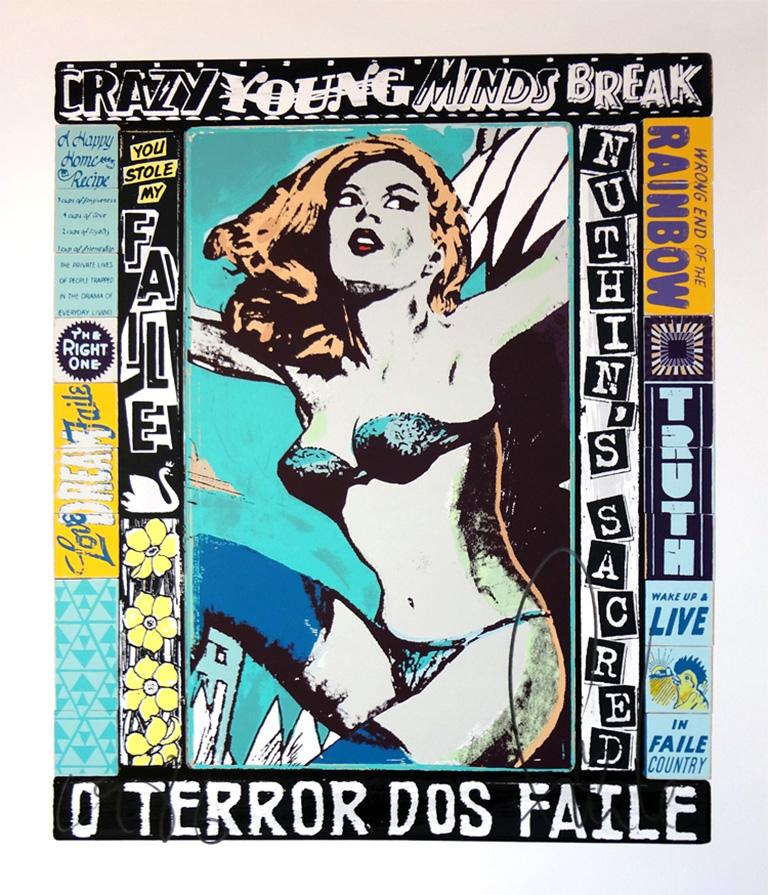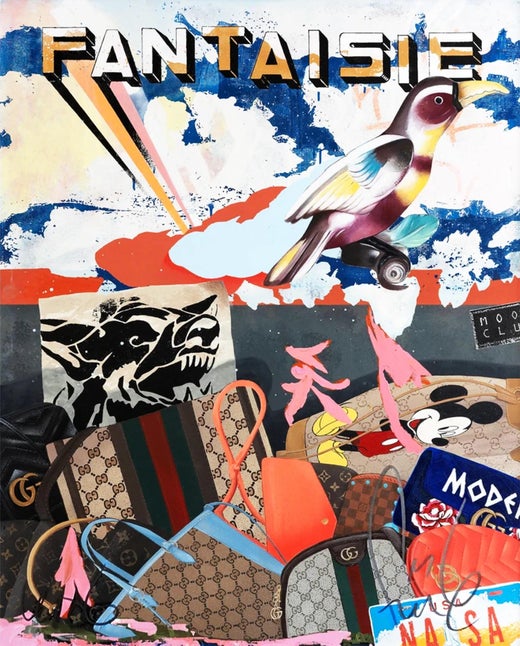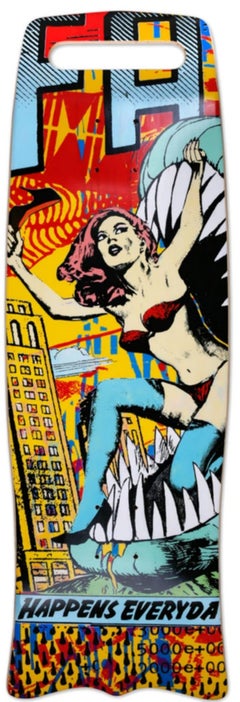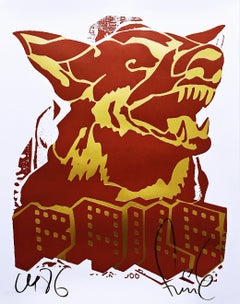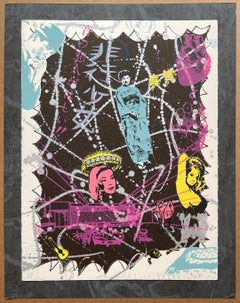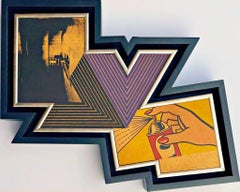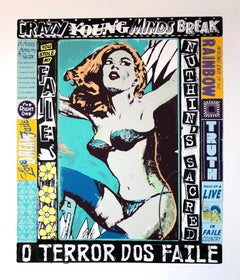Items Similar to Secret Seas: Acrylic, Silkscreen Ink on paper (unique signed numbered variant)
Want more images or videos?
Request additional images or videos from the seller
1 of 10
FaileSecret Seas: Acrylic, Silkscreen Ink on paper (unique signed numbered variant)2019
2019
$1,500
£1,141.88
€1,305.41
CA$2,110.52
A$2,308.56
CHF 1,215.52
MX$27,561.88
NOK 15,491.99
SEK 14,171.47
DKK 9,750.04
About the Item
FAILE
Secret Seas, 2019
Acrylic, Silkscreen Ink on Lenox 100 Paper. (two sided)
Hand Signed, titled, dated and numbered 6/250 (each unique)
25 × 19 inches
Hand signed and annotated on the recto front and numbered and dated on the back
Unique Variant
Unframed
This gorgeous, hand-painted, stained and printed silkscreen by popular street artist Faile is an original work done on elegant thick art paper with one deckled edge (right hand side). The back is also quite special and unique with printing, stamping and embossing. Hand signed and annotated on the lower recto (front) from an varied edition of 250. Note the edition number is 250, but each work, including the present work, is 100% unique. This is truly a two sided work of art so when framed, it should have a plexi back, so both recto and verso can be exhibited interchangeably.
FAILE is the popular Brooklyn-based artistic collaboration between Patrick McNeil and Patrick Miller.
Their name is an anagram of their first project, “A life.” Since its inception in 1999, FAILE has been known for a wide ranging multimedia practice recognizable for its explorations of duality through a fragmented style of appropriation and collage. While painting and printmaking remain central to their approach, over the past decade FAILE has adapted its signature mass culture-driven iconography to vast array of materials and techniques, from wooden boxes and window pallets to more traditional canvas, prints, sculptures, stencils, installation, and prayer wheels. FAILE’s work is constructed from found visual imagery, and blurs the line between “high” and “low” culture, but recent exhibitions demonstrate an emphasis on audience participation, a critique of consumerism, and the incorporation of religious media, architecture, and site-specific/archival research into their work.
- Creator:Faile (American)
- Creation Year:2019
- Dimensions:Height: 25 in (63.5 cm)Width: 19 in (48.26 cm)
- Medium:
- Movement & Style:
- Period:
- Condition:fine condition; unframed.
- Gallery Location:New York, NY
- Reference Number:1stDibs: LU1745213589012
Faile
The art collective Faile, is formed by Patrick Miller and Patrick McNeil. Both artists met at school and studied graphic design. In 1999 they formed a group with the nickname A-Life, under which (and under the influence of a young Shepard Fairey) they began to wheatpaste their posters around the big American cities. Soon they met who would become a third temporary member, the Japanese Aiko Nakagawa. In 2006, she would leave the group to start her own solo career and today is known as Lady Aiko. After an arrest, precisely for wheatpasting, they changed the name of the group to Faile (anagram of A-Life). Soon after they already had created an image and began to expand their brand to other continents sticking their designs on the streets of other cities in Europe and Asia. Like Obey, this group aims to create social criticism, generate artistic interest and awareness. Faile was part of that group of young emerging artists of the urban subculture that promoted the art in the streets. With their printed impressions, Faile promotes the access of the artwork to the general public at affordable prices. They began working with the stencil, preferring this technique because their work would have more durability. Gradually they combined it with painting, mixed media and collage. Thanks to his extensive knowledge in printing techniques, these two artists have taken the collage to another level and in his works can see how many printed layers are superimposed on top of each other to later be torn, suggesting the lower layers. As Mimmo Rotella did a few decades before, Faile creates their own version of the decollage technique. The work of these artists is highly influenced by the comic, film and fiction novels. If we look at the aesthetics of their work we can see how this neo pop art presented to us, represents its own modern version of the aesthetics of Roy Lichtenstein and, as already mentioned, an improved technique of Mimmo Rotella's decollage. All their works explore the world of contradictions and how they complement each other, based on the theory of yin-yang. So opposites as love and hatred, violence and peace or beauty and ugliness share the limelight in their paintings. Faile members currently reside in Brooklyn, New York, where they have their workshop. Their current creations explore media, from traditional canvas to other more diverse as wood or glass. They also have a very prolific activity by editing their own limited edition prints, and creating their own line of merchandising. So far they have published four books with their works entitled "Orange", "Death", "Boredom" and "Lavender”. Their works are internationally recognized and has been exhibited in major galleries around the world. Some of them have come to get tens of thousands of euros.
About the Seller
5.0
Gold Seller
Premium sellers maintaining a 4.3+ rating and 24-hour response times
Established in 2007
1stDibs seller since 2022
476 sales on 1stDibs
Typical response time: 1 hour
- ShippingRetrieving quote...Shipping from: New York, NY
- Return Policy
More From This Seller
View AllHappens Everyday 1986 Lt. Ed. Silkscreen on Canadian Maplewood Skateboard Deck
By Faile
Located in New York, NY
Faile
Happens Everyday 1986, 2018
Silkscreen on 7-Ply Canadian Maplewood Skateboard Deck
30 × 9 3/4 × 3/10 inches
Edition: 66 of 150
Signed on the Deck Fai...
Category
2010s Street Art Mixed Media
Materials
Wood, Screen
Red Dog (limited edition print with gold foil) by famous Street Art Pop Artists
By Faile
Located in New York, NY
FAILE
Red Dog, 2018
Offset Print with gold foil on Lenox 100 paper. Faile studio stamp on the back
Annotated and hand signed in pencil on the lower front with studio stamp on the bac...
Category
2010s Street Art Animal Prints
Materials
Gold Leaf
Bad Girls, Signed 9 color lithograph Pop artist Kenny Scharf Rare Printers Proof
By Kenny Scharf
Located in New York, NY
Kenny Scharf
Bad Girls, 1989
Lithograph done with 9 colors and 10 plates on Velin Arches Blanc paper
Hand signed and numbered PP by Kenny Scharf on the front
Unframed: the work was r...
Category
1980s Pop Art Figurative Prints
Materials
Lithograph
Richard Pettibone The Appropriation Warhol, Stella, Lichtenstein, Unique Signed
By Richard Pettibone
Located in New York, NY
Richard Pettibone
The Appropriation Print Andy Warhol, Frank Stella, Roy Lichtenstein, 1970
Silkscreen in colors on masonite board (unique variant on sculpted board)
Hand-signed by artist, Signed and dated on the front (see close up image)
Bespoke frame Included
This example of Pettibone's iconic Appropriation Print is silkscreened on masonite board rather than paper, giving it a different background hue, and enabling it work to be framed so uniquely.
The Appropriation print is one of the most coveted prints Pettibone ever created ; the regular edition is on a full sheet with white background; the present example was silkscreened on board, allowing it to be framed in 3-D. While we do not know how many examples of this graphic work Pettibone created, so far the present work is the only one example we have ever seen on the public market since 1970. (Other editions of The Appropriation Print have been printed on vellum, wove paper and pink and yellow paper.)
This 1970 homage to Andy Warhol, Frank Stella and Roy Lichtenstein exemplifies the type of artistic appropriation he was engaging in early on during the height of the Pop Art movement - long before more contemporary artists like Deborah Kass, Louise Lawler, etc. followed suit.
This silkscreen was in its original 1970 vintage period frame; a bespoke custom hand cut black wood outer frame was subsequently created especially to house the work, giving it a distinctive sculptural aesthetic.
Measurements:
Framed 14.5 inches vertical by 18 inches horizontal by 2 inches
Work
13 inches vertical by 16.5 inches horizontal
Richard Pettibone biography:
Richard Pettibone (American, b.1938) is one of the pioneering artists to use appropriation techniques. Pettibone was born in Los Angeles, and first worked with shadow boxes and assemblages, illustrating his interest in craft, construction, and working in miniature scales. In 1964, he created the first of his appropriated pieces, two tiny painted “replicas” of the iconic Campbell’s soup cans by Andy Warhol (American, 1928–1987). By 1965, he had created several “replicas” of paintings by American artists, such as Warhol, Roy Lichtenstein (1923–1997), Ed Ruscha (b.1937), and others, among them some of the biggest names in Pop Art. Pettibone chose to recreate the work of leading avant-garde artists whose careers were often centered on themes of replication themselves, further lending irony to his work. Pettibone also created both miniature and life-sized sculptural works, including an exact copy of Bicycle Wheel by Marcel Duchamp (French, 1887–1968), and in the 1980s, an entire series of sculptures of varying sizes replicating the most famous works of Constantin Brancusi (Romanian, 1876–1957). In more recent years, Pettibone has created paintings based on the covers of poetry books by Ezra Pound, as well as sculptures drawn from the grid compositions of Piet Mondrian (Dutch, 1872–1944). Pettibone straddles the lines of appropriation, Pop, and Conceptual Art, and has received critical attention for decades for the important questions his work raises about authorship, craftsmanship, and the original in art. His work has been exhibited at the Institute for Contemporary Art in Philadelphia, the Museum of Modern Art in New York, the Museum of Contemporary Art in Miami, and the Laguna Art Museum in Laguna Beach, CA. Pettibone is currently based in New York.
"I wished I had stuck with the idea of just painting the same
painting like the soup can and never painting another painting.
When someone wanted one, you would just do another one.
Does anybody do that now?"
Andy Warhol, 1981
Since the mid-1960s, Richard Pettibone has been making
hand-painted, small-scale copies of works by other artists — a
practice due to which he is best known as a precursor of appropriation art — and for a decade now, he has been revisiting subjects from across his career. In his latest exhibitions at
Castelli Gallery, Pettibone has been showing more of the “same”
paintings that had already been part of his 2005–6 museum retrospective,1
and also including “new” subject matter drawn from
his usual roster of European modernists and American postwar
artists. Art critic Kim Levin laid out some phases of the intricate spectrum from copies to repetitions in her review of the
Warhol-de Chirico showdown, a joint exhibition at the heyday
of appropriation art in the mid-1980s when Warhol’s appropriations of de Chirico’s work effectively revaluated “the grand
old auto-appropriator”.
Upon having counted well over a dozen
Disquieting Muses by de Chirico, Levin speculated: “Maybe he
kept doing them because no one got the point. Maybe he needed the money. Maybe he meant it when he said his technique
had improved, and traditional skills were what mattered.”
On
the other side, Warhol, in her eyes, was the “latter-day exemplar
of museless creativity”.
To Pettibone, traditional skills certainly
still matter, as he practices his contemporary version of museless creativity. He paints the same painting again and again,
no matter whether anybody shows an interest in it or not. His
work, of course, takes place well outside the historical framework of what Levin aptly referred to as the “modern/postmodern wrestling match”,
but neither was this exactly his match
to begin with.
Pettibone is one of appropriation art’s trailblazers, but his diverse
selection of sources removes from his work the critique of the
modernist myth of originality most commonly associated with
appropriation art in a narrow sense, as we see, for example, in
Sherrie Levine’s practice of re-photographing the work of Walker
Evans and Edward Weston. In particular, during his photorealist
phase of the 1970s, Pettibone’s sources ranged widely across
several art-historical periods. His appropriations of the 1980s
and 1990s spanned from Picasso etchings and Brancusi sculptures to Shaker furniture and even included Ezra Pound’s poetry.
Pettibone has professed outright admiration for his source artists, whose work he shrinks and tweaks to comic effect but, nevertheless, always treats with reverence and care. His response
to these artists is primarily on an aesthetic level, owing much
to the fact that his process relies on photographs. By the same
token, the aesthetic that attracts him is a graphic one that lends
itself to reproduction. Painstakingly copying other artists’ work by hand has been a way of making
it his own, yet each source is acknowledged in
his titles and, occasionally, in captions on white
margins that he leaves around the image as an
indication that the actual source is a photographic image. The enjoyment he receives in copying
is part of the motivation behind doing it, as is
the pleasure he receives from actually being with
the finished painting — a considerable private
dimension of his work. His copies are “handmade
readymades” that he meticulously paints in great quantities in his studio upstate in New York; the commitment
to manual labor and the time spent at material production has
become an increasingly important dimension of his recent work.
Pettibone operates at some remove from the contemporary art
scene, not only by staying put geographically, but also by refusing to recoup the simulated lack of originality through the
creation of a public persona.
In so doing, Pettibone takes a real
risk. He places himself in opposition to conceptualism, and he is
apprehensive of an understanding of art as the mere illustration
of an idea. His reading of Marcel Duchamp’s works as beautiful
is revealing about Pettibone’s priorities in this respect.
When
Pettibone, for aesthetic pleasure, paints Duchamp’s Poster for
the Third French Chess...
Category
1970s Pop Art Abstract Prints
Materials
Masonite, Pencil, Screen
Untitled, expressionistic woodcut print, from the Art Against AIDS Portfolio
By James Bettison
Located in New York, NY
James Bettison
Untitled, from the Art Against AIDS Portfolio, 1988
Woodcut on paper with deckled edges. Hand signed. Numbered 38/50. Dated. Printer's and Publisher's Blind Stamp.
20...
Category
1980s Contemporary Abstract Prints
Materials
Woodcut, Pencil
Roy Lichtenstein Rare Brooklyn Academy print Hand signed warmly inscribed, dated
By Roy Lichtenstein
Located in New York, NY
Roy Lichtenstein
Next Wave Festival Poster (Hand signed, warmly inscribed and dated), 1983
Offset lithograph (hand signed, uniquely inscribed, and dated by Roy Lichtenstein)
Signed, ...
Category
1980s Pop Art Abstract Prints
Materials
Lithograph, Offset
You May Also Like
FAILE - THE RIGHT ONE, HAPPENS EVERYDAY Pop Street art American Pin-Up Design
By Faile
Located in Madrid, Madrid
FAILE - THE RIGHT ONE, HAPPENS EVERYDAY
Date of creation: 2014
Medium: Screen print on Coventry Rag paper
Edition number: 418/450
Size: 71 x 61 cm
Condition: In mint conditions, bran...
Category
2010s Modern Figurative Prints
Materials
Paper, Screen
$1,410 Sale Price
20% Off
"Almost Rapture" 23 Color Silkscreen Print, Limited Edition, SSYM Series
By Faile
Located in Palm Desert, CA
"Almost Rapture" by FAILE is a 23 color silkscreen print on Coventry Rag 325 gsm with deckled edges, 23 x 35 Inches. Signed, embossed, stamped and numbered (17/300) in the FAILE stud...
Category
2010s Street Art Figurative Prints
Materials
Screen
"Bad Seeds" 24 Color Silkscreen Print, Limited Edition, SSYM Series
By Faile
Located in Palm Desert, CA
"Bad Seeds" by FAILE is a 24 color silkscreen print on Coventry Rag 325 gsm with deckled edges, 23 x 35 Inches. Signed, embossed, stamped and numbered (67/300) in the FAILE studio.
...
Category
2010s Street Art Figurative Prints
Materials
Screen
"Invasion Dream Club" 21 Color Silkscreen Print, Limited Edition, SSYM Series
By Faile
Located in Palm Desert, CA
"Invasion Dream Club" by FAILE is a 21 color silkscreen print on Coventry Rag 325 gsm with deckled edges, 23 x 35 Inches. Signed, embossed, stamped and numbered (59/300) in the FAILE...
Category
2010s Street Art Figurative Prints
Materials
Screen
Faile Couture Signed and Numbered Print
By Faile
Located in Draper, UT
'Couture' by Faile, 2022
24 x 26 Inches
Archival pigment print on 280gsm Entrada Cotton Rag fine art paper.
Limited Edition of 300
Hand-signed by the artist duo bottom right.
Artist...
Category
15th Century and Earlier Street Art Animal Prints
Materials
Lithograph, Screen
Stages, 2017 Signed metallic offset lithograph on glossy paper
By Faile
Located in Draper, UT
FAILE
Stages, 2017
Signed metallic offset lithograph on glossy paper
Created by Brooklyn-based artist duo FAILE (Patrick McNeil and Patrick Miller), Stages captures the energy of t...
Category
2010s Street Art More Art
Materials
Screen
More Ways To Browse
Wooden Windows
Richard Reed
Robert Motherwell Elegy
Robert Natkin Lithograph
Shinoda Toko
Sister Corita Prints
Vintage Field And Stream Cover Art
Warhol Rose
11 Pop Artists
Agam Agamograph
Alexander Calder Braniff
Anuszkiewicz Signed
Arthur Boyd
Ballet Russe Costume
Calder Print Sun
Cobra Art Signed
Dollar Bill Painting
Exhibition Poster 1984
